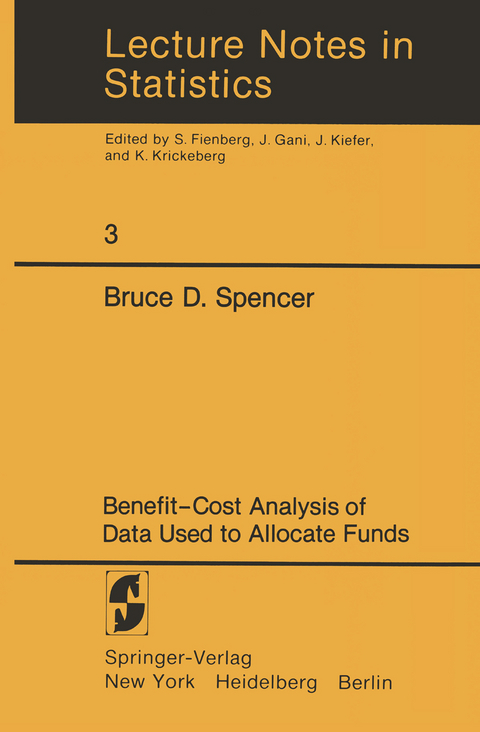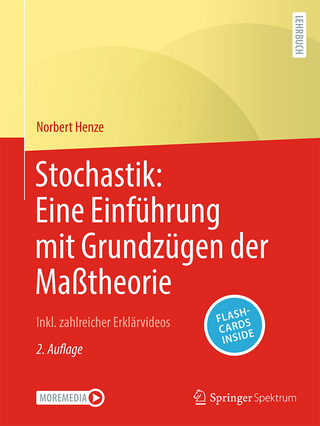
Benefit-Cost Analysis of Data Used to Allocate Funds
Springer-Verlag New York Inc.
978-0-387-90511-2 (ISBN)
This monograph treats the question of determining how much to spend for the collection and analysis of public data. This difficult problem for government statisticians and policy-makers is likely to become even more pressing in the near future. The approach taken here is to estimate and compare the benefits and costs of alternative data programs. Since data are used in many ways, the benefits are hard to measure. The strategy I have adopted focuses on use of data to determine fund allocations, particularly in the General Revenue Sharing program. General Revenue Sharing is one of the largest allocation programs in the United States. That errors in population counts and other data cause sizable errors in allocation has been much publicized. Here we analyze whether the accuracy of the 1970 census of population and other data used by General Revenue Sharing should be improved. Of course it is too late to change the 1970 census program, but the method and techniques of analysis will apply to future data programs. In partic ular, benefit-cost analyses such as this are necessary for informed decisions about whether the expense of statistical programs is justi fied or not. For example, although a law authorizing a mid-decade census was enacted in 1976, there exists great doubt whether funds will be provided so a census can take place in 1985. (The President's Budget for 1981 allows no money for the mid-decade census, despite the Census Bureau's request for $1. 9 million for planning purposes.
0 Introduction.- 1 Loss Function and Benefit Measurement.- §1.0 Introduction.- 1.1 Utility and Social Welfare.- 1.2 Equity.- 1.3 A Simple Loss Function.- Errors in Allocation.- 1.4 Estimating the Parameters of the Loss Function L(f?,??) for GRS.- 1.5 Fisher-Consistency and Other Properties of the Loss Function L(f?,??).- 1.6 More General Loss Functions: LH(f?,??) , Lw(f?,??).- 1.7 Exponential Loss Functions.- 2 The Delta Method.- §2.0 Outline.- 2.1 Notation.- 2.2 Description of the Delta Method.- 2.3 Applicability of the Delta Method to GRS.- 2.4 Application of the Delta Method to Calculating Expected Loss.- 3 Data Used in General Revenue Sharing.- §3.1 Introduction.- 3.2 Population (state level).- 3.3 Urbanized Population.- 3.4 Population (substate level).- 3.5 Total Money Income, Per Capita Income (state level).- 3.6 Per Capita Income (substate level).- 3.7 Personal Income.- 3.8 Net State and Local Taxes.- 3.9 State Individual Income Taxes.- 3.10 Federal Individual Income Tax Liabilities.- 3.11 Income Tax Amount (state level).- 3.12 Adjusted Taxes (substate level).- 3.13 Intergovernmental Transfers (substate level).- 3.14 Interrelationships Among State- level Data Elements.- 3.15 Interrelationships Among Substate Data Elements.- 3.16 Outline-Symbol Glossary.- 4 Interstate Allocation in GRS §4.1 Introduction 151.- 4.2 Notation.- 4.3 Conclusions.- 4.4 Assumptions and Degrees of Approximation.- 4.5 Derivations and Proofs.- 5 Intrastate Allocations in GRS.- §5.1 Overview.- 5.2 Determination of Substate Allocations.- 5.3 Notation.- 5.4 Assumptions and Degrees of Approximations.- 5.5 Conclusions.- 6 Computations and Analyses.- §6.1 Introduction.- 6.2 Errors in Allocation to States.- 6.3 Substate Errors in Allocation.- 6.4 Benefit Analysis.- 6.5Summary of Findings.- 7 Policy Perspectives and Recommendations.- §7.0 Introduction and Summary.- 7.1 Redundancy cf Allocation Formulas.- 7.2 Data Burdens Imposed by Legislation.- 7.3 Minimizing Large Errors in Allocation.- 7.4 Uniform Biases, Non-uniform Variances.- 7.5 Adjusting for Undercoverage or Other Suspected Biases.- 7.6 Improving the Coverage of the Decennial Census.- 7.7 State Errors vs. Substate Errors.- 7.8 Allocation Formulas as Approximations.- 7.9 Other Uses of Data.- Appendix A Tables of Biases in Data.- Appendix B Determination of General Revenue Sharing Allocations.- Technical Appendix.
| Erscheint lt. Verlag | 2.9.1980 |
|---|---|
| Reihe/Serie | Lecture Notes in Statistics ; 3 |
| Zusatzinfo | 296 p. |
| Verlagsort | New York, NY |
| Sprache | englisch |
| Maße | 155 x 235 mm |
| Themenwelt | Mathematik / Informatik ► Mathematik ► Wahrscheinlichkeit / Kombinatorik |
| Recht / Steuern ► Steuern / Steuerrecht | |
| Sozialwissenschaften ► Politik / Verwaltung ► Staat / Verwaltung | |
| Technik ► Architektur | |
| Wirtschaft ► Allgemeines / Lexika | |
| Wirtschaft ► Volkswirtschaftslehre ► Ökonometrie | |
| Wirtschaft ► Volkswirtschaftslehre ► Wirtschaftspolitik | |
| ISBN-10 | 0-387-90511-1 / 0387905111 |
| ISBN-13 | 978-0-387-90511-2 / 9780387905112 |
| Zustand | Neuware |
| Haben Sie eine Frage zum Produkt? |
aus dem Bereich


